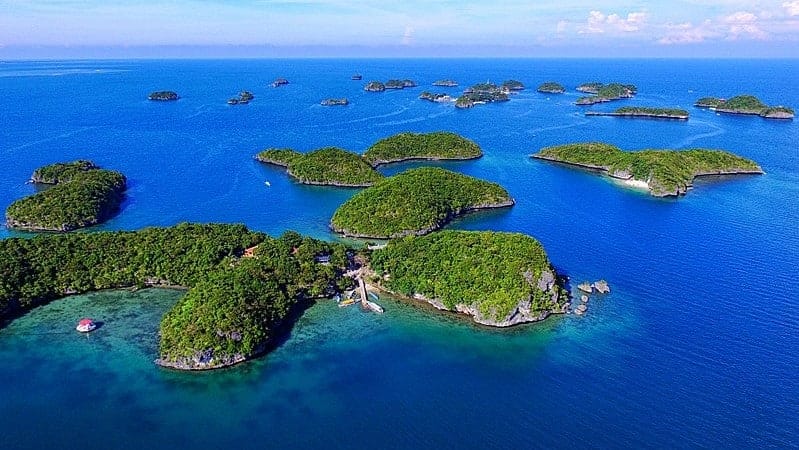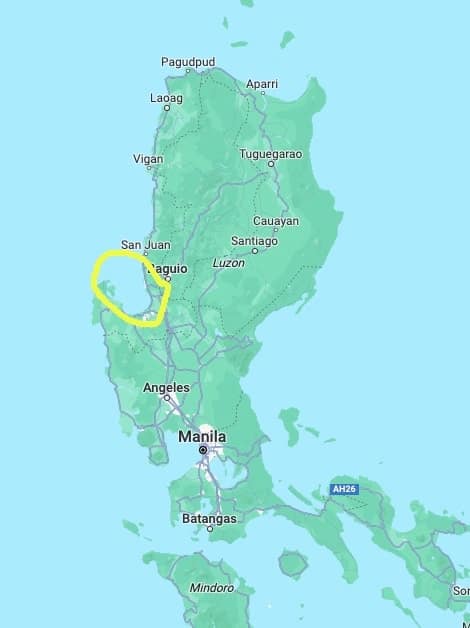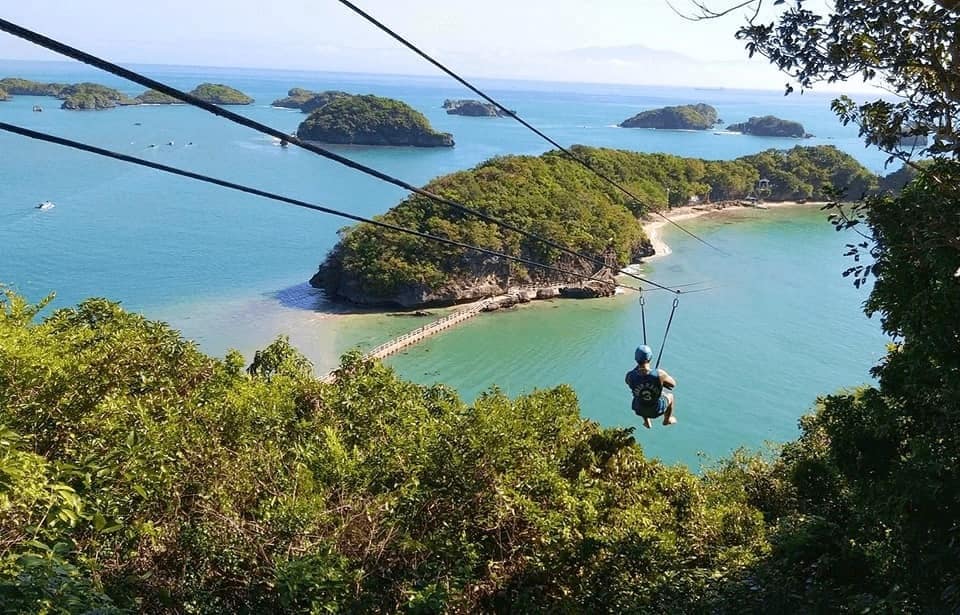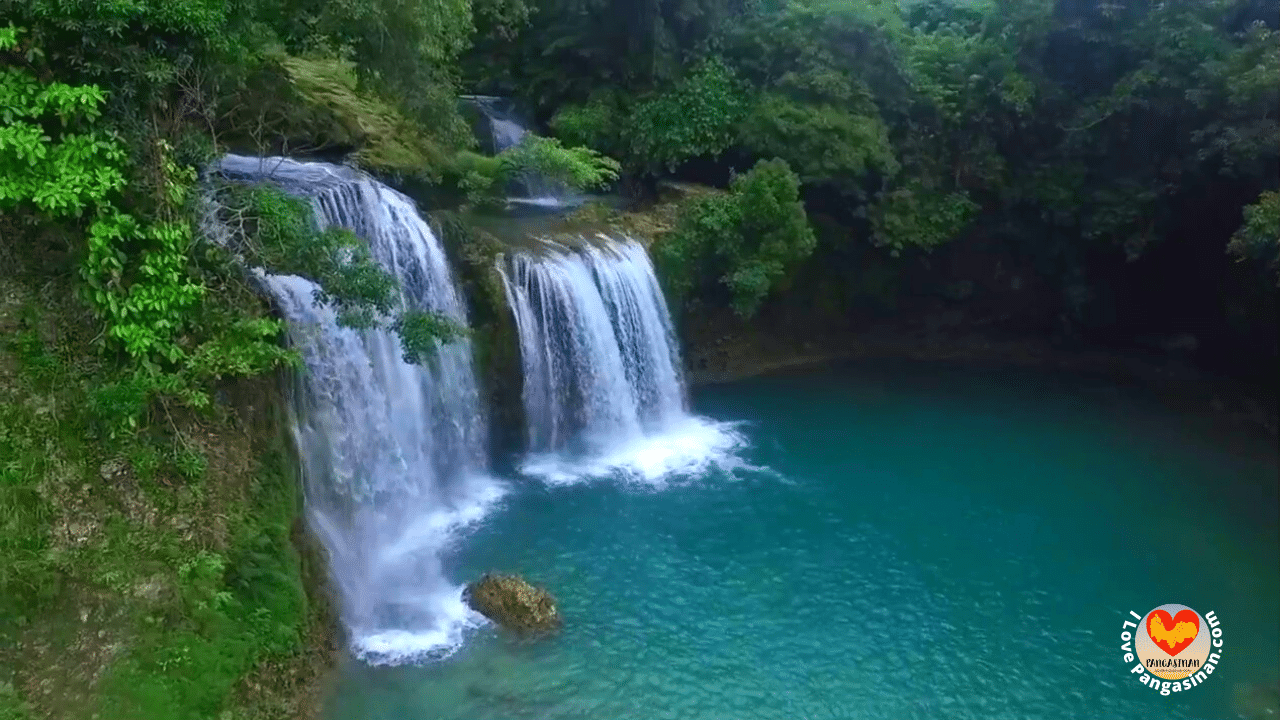Introduction: Unveiling the Mysteries of Hundred Islands
 Located off the northern coast of Luzon in the Philippines, the Hundred Islands National Park is a mesmerizing cluster of 124 islands and islets scattered in the Lingayen Gulf. Its pristine beaches, limestone formations, and diverse marine life make it a must-visit tropical paradise.
Located off the northern coast of Luzon in the Philippines, the Hundred Islands National Park is a mesmerizing cluster of 124 islands and islets scattered in the Lingayen Gulf. Its pristine beaches, limestone formations, and diverse marine life make it a must-visit tropical paradise.
Natural Beauty Beyond Numbers
Though named ‘Hundred Islands’, this national park boasts more than just its count. The islands, mostly made of ancient coral reefs that emerged from the sea, offer a diverse array of natural attractions.
- Quezon Island: Named after a Philippine president, it’s one of the most developed and frequently visited islands, known for its beaches and recreational activities.
- Marcos Island: Not just famous for its sandy shores, it also hides the enchanting Imelda Cave, perfect for spelunking enthusiasts.
- Children’s Island: As the name suggests, its shallow waters make it ideal for families with kids.

Thrilling Adventures Await
For thrill-seekers, the Hundred Islands offer more than just beach lounging.
- Snorkeling & Diving: Dive into crystal clear waters and discover vibrant coral gardens, schools of colorful fish, and hidden underwater caves.
- Kayaking: Explore the islands at your own pace, navigating through lagoons and hidden coves.
- Ziplining: For a panoramic view of the park, take a zipline ride from Governor’s Island to Virgin Island.
Conservation Matters: Protecting a National Treasure
Recognized for its ecological significance, efforts are in place to protect the delicate ecosystem of the Hundred Islands. Sustainable tourism practices are encouraged, and visitors are educated about minimizing their environmental footprint.
Getting there: Making the Trip to Hundred Islands
Situated near the town of Alaminos in Pangasinan, the park is accessible via land travel from major cities like Manila. Upon reaching Alaminos, local boats or ‘bangkas’ ferry visitors to their island of choice. Here are some options:
1. By Private Vehicle:
For those traveling from Manila:
- Take the North Luzon Expressway (NLEX).
- Merge into the Subic-Clark-Tarlac Expressway (SCTEX) and follow the direction heading to Tarlac.
- From SCTEX, head to the Tarlac-Pangasinan-La Union Expressway (TPLEX).
- Exit at Urdaneta and then follow the national road going to Alaminos, Pangasinan.
- The drive usually takes around 4-5 hours, depending on traffic conditions.
2. By Public Bus:
There are several bus companies in Manila that offer daily trips to Alaminos.
- Bus Terminals: Check terminals located in Cubao, Quezon City, Pasay, and Manila. Companies such as Victory Liner and Five Star Bus have regular trips to Alaminos.
- Travel Time: The journey by bus can take around 5-6 hours, depending on traffic and the number of stops.
- Tips: It’s advisable to check the bus schedule ahead of time and, if possible, reserve your tickets, especially during peak seasons.
3. By Air:
While there’s no direct airport in Alaminos, the nearest airport is in Lingayen, Pangasinan. However, flights to Lingayen are limited.
- If you choose to fly, you’ll likely land in Clark International Airport in Pampanga or Ninoy Aquino International Airport in Manila. From there, you can take a bus or a private vehicle to Alaminos.
4. Side Trip Options:
If you have extra time or are looking for side trips:
- Bolinao: Located northwest of Alaminos, Bolinao boasts beautiful beaches and the stunning Bolinao Falls.
Bolinao Falls - Manaoag: This town, located en route to Alaminos when coming from Manila, is known for the Our Lady of Manaoag Shrine, a popular pilgrimage site.
Conclusion: Hundred Islands, A Tropical Haven
With its myriad of natural wonders, from hidden caves to teeming underwater sanctuaries, the Hundred Islands National Park is a testament to the Philippines’ reputation as a premier island destination. Whether you’re an adventurer, a nature lover, or someone seeking solace by the sea, this archipelagic wonder has something for everyone.
And if 100 islands ain’t enough, there are 82 more just along the boat tour expeditions between El Nido and Coron that we organize in Palawan.
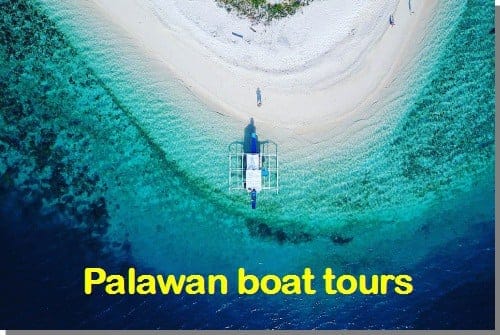
Experience the thrill of island hopping in the Philippines
FAQs
What is the Hundred Islands National Park known for?
The Hundred Islands National Park is a mesmerizing archipelago of 124 islands and islets sprinkled across the cerulean waters of Lingayen Gulf in Pangasinan. It’s famed for its diverse marine life, pristine beaches, limestone cliffs, and enchanting caves, making it a must-visit tropical paradise.
Why should you visit the Hundred Islands?
A trip to the Hundred Islands is a journey into nature’s splendor! Dive into crystal-clear waters, snorkel amidst vibrant coral gardens, and explore hidden lagoons and caves. Whether you’re a thrill-seeker, a nature lover, or someone seeking relaxation, these islands promise unforgettable experiences.
Is Hundred Island worth visiting?
Absolutely! The Hundred Islands offer a unique island-hopping experience. With each island boasting its own charm, from secluded beaches to adrenaline-pumping activities like zip-lining, there’s something for everyone in this picturesque haven.
What are the interesting facts about the Hundred Islands?
Dive into a world where nature reigns supreme at the Hundred Islands! These ancient gems, over two million years old, comprise 124 islands and islets, with each one telling its own story. While only three islands—Governor, Quezon, and Children’s Island—are developed for visitors, the rest remain untouched, teeming with local legends and unique wildlife, including the elusive Philippine sailfin lizard.
What is the biggest island in Hundred Islands?
Towering over its siblings, Quezon Island is the grandest of the Hundred Islands. Dedicated to the Philippines’ second president, Manuel L. Quezon, this island is not only vast in size but also in experiences, from sun-kissed beaches to panoramic viewpoints.
How many hours from Baguio to Hundred Islands?
Eager to swap the cool climes of Baguio for the tropical allure of the Hundred Islands? You’re just 3 to 4 hours away, depending on the route and traffic, from this island paradise.
How do I get from Baguio city to Hundred Islands?
From Baguio’s misty peaks, board a bus heading to Dagupan or Alaminos. Once you reach Alaminos, local tricycles or jeepneys eagerly await to whisk you to Lucap Wharf, your gateway to the enchanting Hundred Islands. If you’re keen on a seamless journey, consider hiring a private vehicle.
How many islands can you visit in Hundred Islands?
Amidst the Hundred Islands’ sprawling archipelago, a handful stands out for their beauty and accessibility. Tourists frequently set foot on Governor Island, Quezon Island, Children’s Island, and Marcos Island. But with a zest for adventure and a private boat, there’s no limit to the hidden treasures you can uncover!
What is the best month to visit Hundred Islands?
Dreaming of sunlit shores and tranquil seas? December to May is your golden window to visit the Hundred Islands. This dry season promises idyllic weather for all your island escapades. However, a quick tip: April, especially during Holy Week, can see a surge in visitors, so if solitude is on your wishlist, plan accordingly!
SEO Keywords: Hundred Islands National Park, Luzon, Philippines, Lingayen Gulf, Quezon Island, Marcos Island, snorkeling, diving, sustainable tourism, Alaminos, Pangasinan, coral reefs, archipelagic adventure.
Booking – joining group tours
Here’s a curated list of reputable group boat tour operators for island hopping in Hundred Islands National Park (San Fernando Gulf), Pangasinan — perfect for families, friends, team-building, or large groups:
1. Hundred Islands Package Tour (Facebook page)
-
Type: Private-service boat rentals (group tours)
-
Highlights: Tailored island-hopping packages; includes boat, guide, registration
-
Contact: 0906‑467‑8129 / 0930‑3652‑814 (via Facebook) tripadvisor.com+15facebook.com+15getmyboat.com+15enjoykadito.com+5viator.com+5guidetothephilippines.ph+5
2. Rhecho Travel and Tours
-
Type: Local Alaminos operator
-
Highlights: Boat rentals, package tours, van rental, team building
-
Contact: via Facebook “Rhecho100islands” getmyboat.com+10facebook.com+10pltravelservices.com+10
3. PL Travel Services (DOT-accredited)
-
Type: Full-day packages including van transfer from Manila
-
Highlights: Boat rental, entrance fees, permits, insurance
-
Contact:
-
Landline (Metro Manila): 02‑7218‑3931
-
Sun: 0942‑951‑0659 · Globe/Smart: 0995‑429‑0116 · Viber/WhatsApp: +63 995 429 0116
-
Email: pltravelservices12@gmail.com guidetothephilippines.ph+15pltravelservices.com+15travel-buddies.com+15
-
4. Shore Excursions Asia
-
Type: Shore-excursion tours (great for cruise groups)
-
Highlights: 6-hour island hopping with snorkeling, cliff jumps, trekking
-
Contact: Hotline +84 964 640 313 (Vietnam-based operator) travel-buddies.com+3philippinestravelpackage.com+3viator.com+3pltravelservices.com+5getyourguide.com+5philippinestravelpackage.com+5shoreexcursions.asia
5. SRRB Tour Services (Tripadvisor / Viator)
-
Type: Licensed, seat‑in‑coach day tours
-
Highlights: 3–6 island visits, snorkeling gear, guide, van transfer option via Viator
-
Contact: Book via Viator (“Hundred Islands National Park Day Tour”) pltravelservices.com+15tripadvisor.com+15viator.com+15facebook.com+8viator.com+8travel-buddies.com+8
6. GetYourGuide – Manila Guided Tour
-
Type: Guided group tour from Makati
-
Highlights: Transfers, multiple water activities (snorkeling, kayaking, rappelling, zip‑lining, cliff jumping)
-
Contact: Bookable on GetYourGuide under “From Manila: Pangasinan Hundred Islands Guided Tour” guidetothephilippines.ph+4getyourguide.com+4philippinestravelpackage.com+4
7. Travel Buddies – Day Tour with Transfer
-
Type: Private small-group day tour from Manila
-
Highlights: Van transport, snorkeling, lunch, insurance; approx. ₱6,000/person (~US $120)
8. GuideToThePhilippines – Island Tour with Lunch & Transfers
-
Type: Seat‑in‑coach day tour
-
Highlights: Visit 3 islands, includes lunch, insurance, guide, transfers from Alaminos City hotel tripadvisor.com+3guidetothephilippines.ph+3facebook.com+3
9. Enjoy Ka Dito!
-
Type: Private tour packages
-
Highlights: All-inclusive boat ride from Lucap port, food (boodle fight!), guide, insurance; add-ons: snorkeling, kayaking, zip‑lining, jetski, parasailing travel-buddies.com+15enjoykadito.com+15reddit.com+15
-
Contact: yesenjoykadito@yahoo.com (or via Facebook “EnjoyKaDito”) philippinestravelpackage.com+5enjoykadito.com+5en.wikipedia.org+5
🎯 Tips for Choosing:
-
Large groups / team-building: Enjoy Ka Dito or Rhecho Travel – both offer private packages with added activities.
-
Cruise-tied / short visit: Shore Excursions Asia’s tailored options are a fit.
-
Full-day trip from Manila: SRRB (seat‑in‑coach) or Travel Buddies (private) include transfers and multi-island stops.
-
Bang-for-buck: Local private boat rentals from Facebook-listed operators are cost-effective for DIY trips.
🛥️ Self-Rent Option
-
GetMyBoat listing: Private boat rental (~₱1,200/day) for up to 15 guests — includes captain. Book via GetMyBoat’s “Affordable Hundred Islands Boat Rental” page facebook.com+1enjoykadito.com+1shoreexcursions.asiaviator.com+1travel-buddies.com+1getmyboat.com.
📋 Summary Table
| Operator | Type | Inclusions | Contact |
|---|---|---|---|
| Hundred Islands Package Tour | Private boats | Guide, registration | 0906‑467‑8129 |
| Rhecho Travel | Local operator | Boat, van, guide | |
| PL Travel Services | DOT‑accredited | Transport, permits, guide | 02‑7218‑3931 / 0942‑951‑0659 |
| Shore Excursions Asia | Shore-excursion | Guide, gear, itinerary | +84 964 640 313 |
| SRRB Tour via Viator | Day seat-in-coach | Gear, guide, boat ride | Viator |
| GetYourGuide Manila Tour | Full-day | Transfer, activities | GetYourGuide |
| Travel Buddies | Private day tour | Transfer, lunch, guide | Online |
| GuideToThePhilippines | Seat-in-coach | Lunch, guide, insurance | GuideToThePhilippines |
| Enjoy Ka Dito! | Private/recreation | Meals, add-ons | yesenjoykadito@yahoo.com |
| GetMyBoat rental | DIY | Boat & captain only | GetMyBoat site |
Booking - Private Tours
We are a family operation and would love to show you around our beautiful country. We primarily focus on private tours catering to clients interested in a custom and unique experience. Otherwise we offer lots of free information on these pages for budget travelers. Feel free to contact us so we can design the perfect package for you!
Home » Luzon » Explore »

Good recommandation for the overnight stay.
The crew was very helpful
and they prepared very nice meals for us.
Strongly recommended
I wanted to surprise my girlfriend with a special engagement in beautiful El Nido!!
Melasel arranged everything for me and had so many great suggestions and knowledge of how to make this a magical day! I was super worried because it is difficult to arrange such an important event when you live on the other side of the world! But Mel was amazing and understood exactly what I wanted! And went out of her way to accommodate all my requests!
She even had a clever story to tell my girlfriend to cover the photographer being with us all day!
On the day the weather was very rainy with many showers. Mel and Rene were in constant contact with me with plan B and even contacted our hotel to discuss options of hosting the proposal there. Completely above and beyond what I paid for.
Luckily in the end the weather gave us a small window and Mel set everything up beautifully on a sand bar floating in the middle of crystal clear waters surrounded by limestone islands with stunning rocky formations.
Island Hopping in the Philippines somehow peered into my brain and delivered a perfect replica of the proposal I had in my head.
It was simply perfect down to the smallest detail! Thank you so much, I cannot recommend you guys enough!!
As most of people usually feel, once your money has been transferred out to someone you do not know, you probably frustrated that your money would not be able to be refunded.
But not in my experience. I dont need to be worry, the owner refunded me the money he has received (minus the bank fees). He promised to refund me and he did it. It was around 18.700 Pesos.
So, eventhough i didn't manage to go with the tour, but i am really satisfied with their legitimate and great business practice. Hopefully, people will try their services and not worry about their legit business!
Thanks a lot!
First of all the booking part was really simple. I organized this trip to the Philippines last minute for my family (my parents and my uncles) but Karel answered all my questions very quickly and really made everything easier for me. It was an incredible experience. Albert, our tour leader, is a wonderful guy, always smiling and ready to help us. They assisted us in everything and really took care of making everything go smoothly. The accommodation on the islands is as spartan as you expect but the location of each hut alone is worth the trip. The wonder of nature was then added to the goodness of cuisine. It's really difficult to argue how you can cook all that goodness on a boat.
If you are looking for an authentic experience, in contact with nature, off the beaten track, this company's private expedition is certainly for you.
Super ultimate tour is the best with Kayangan and barracuda lake, twin lagoons (my favorite), coral garden (blue fabulous coral) were the best. It’s really worth it to pay for private tour (3500 to 4000 PHP). You will also have to pay for entrance fees (150 to 200PHP by location) and eventually shopping at the market - must do (count 300 for 2 for fish, pork, fruits and vegetables, water).
Based on the comments, I contacted Mel.
Very responsive, very efficient and perfect organization.
The on-board staff were very friendly and very helpful.
And I'm not even talking about the meal on board...a marvel.
In all fairness, this excursion will remain an excellent memory and I cannot recommend Mel and his team highly enough.
A big thank-you.
If you love camping this is definitely a tout you should do, it has been the highlight of our trip!!
We are a family operation managing private custom boat tours in the beautiful Palawan area, and are happy to help travelers with their plans through the country, having traveled a lot of it ourselves and planning to visit it all.
Submit your review | |
My 1st time in Hundred Islands. The tour is beautiful and breathtaking. Also experienced the Pilgrimage of Station of the Cross in the island. a lot of walking but all worth it. The view of scenery is simply awesome. A lot of activities too, like cliff jumping, banana boat, snorkeling and swimming of course. We get to enjoy the water in Marcos Island. The water is clear, and the sand is not rocky. I would love to go back here again with friends and other family members.
